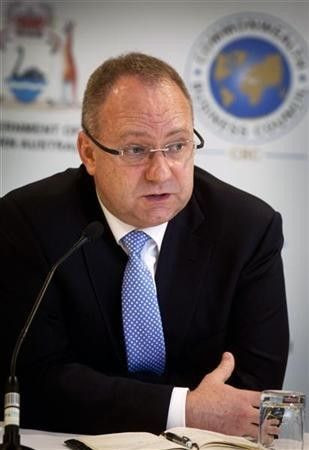AngloGold aims deep on a global level

The chief executive of AngloGold Ashanti said the world's No. 3 gold producer could employ deep-mining technology under development in South Africa in other countries, with future ore discoveries expected to be far below the surface.
AngloGold in South Africa aims to go from 4 kms (2-1/2 miles) down to 5 kms by using radical techniques such as cutting rocks instead of blasting to unlock 70 million additional ounces of gold.
This can be applied elsewhere, whether it is 500 meters or 5,000 meters, Chief Executive Mark Cutifani said in a telephone interview on Wednesday after the group unveiled a surge in third-quarter earnings that beat market expectations.
He also said he expected to find ore bodies at South African depths outside the country and that it was vital to get the technology right now.
The one underlying message is that we have done a pretty good job finding the shallow stuff. But most of the world's ore bodies that we find in the future will be deeper, he said.
AngloGold currently operates the world's deepest mines, and its Mponeng operation in South Africa is about 4 km down. Asked if he expected to find ore bodies at similar depths elsewhere, Cutifani said: I think we can.
In Australia we are at 1,000 meters, and we don't have the bottom of the ore body at Sunrise Dam mine, so who knows? In Brazil we've got operations down to 2.5 kms, and we don't see the bottom of the ore body there, he said.
SOUTH AFRICA TRAIL-BLAZER
Miners in South Africa are blazing the technological trail to depths that until recently would have seemed like science fiction.
The nature of the reef structure in South Africa makes it particularly suited to these sets of technology changes, Cutifani said.
These changes involve replacing blasting with machines to mechanically cut the rock and removing workers from the narrow passages known as stopes.
AngloGold has signaled it wants a working model for this transition in three to five years.
It will take another five years to covert the whole operation in South Africa to that style of mining, Cutifani said.
South Africa's mines are also among the most dangerous in the world, and the safety benefits of mechanization and eliminating blasting, especially at such depths, are obvious.
But there have been concerns about job losses, a sensitive topic in a country of 50 million people with an unemployment rate of over 25 percent.
If a mine's life ends, however, because it can go no deeper, then no one would have a job, Cutifani said.
There is no doubt that over time we will need less people in the key jobs ... If we don't do this, the lives of the mines will finish a lot earlier. But if we do this, we get another 50 years and 70 million ounces, he said.
The record peaks recently scale by gold prices make a journey to the bowels of the earth far more enticing, but the capital expenditure on the project has been minimal.
Cutifani said AngloGold has been spending about $10 million a year on it, which he said was less than half of one percent of our capital spend.
That could be a bargain given that 70 million ounces at current spot prices is a resource worth $126 billion.
AngloGold has also said it aims to raise its output to 5.5 million ounces by 2014 from a target this year of 4.33 million ounces. Over the same period, it projects that South Africa's contribution to the company's global output will fall to 31 percent from 39 percent.
Cutifani said this was because operations elsewhere were projected to rise, while South Africa holds steady at 1.6 million or 1.7 million ounces a year. Without the new technology domestic production would start to dwindle, he said.
It is about extending existing production levels, making it safer and extending the life of the mines.
© Copyright Thomson Reuters 2024. All rights reserved.





















